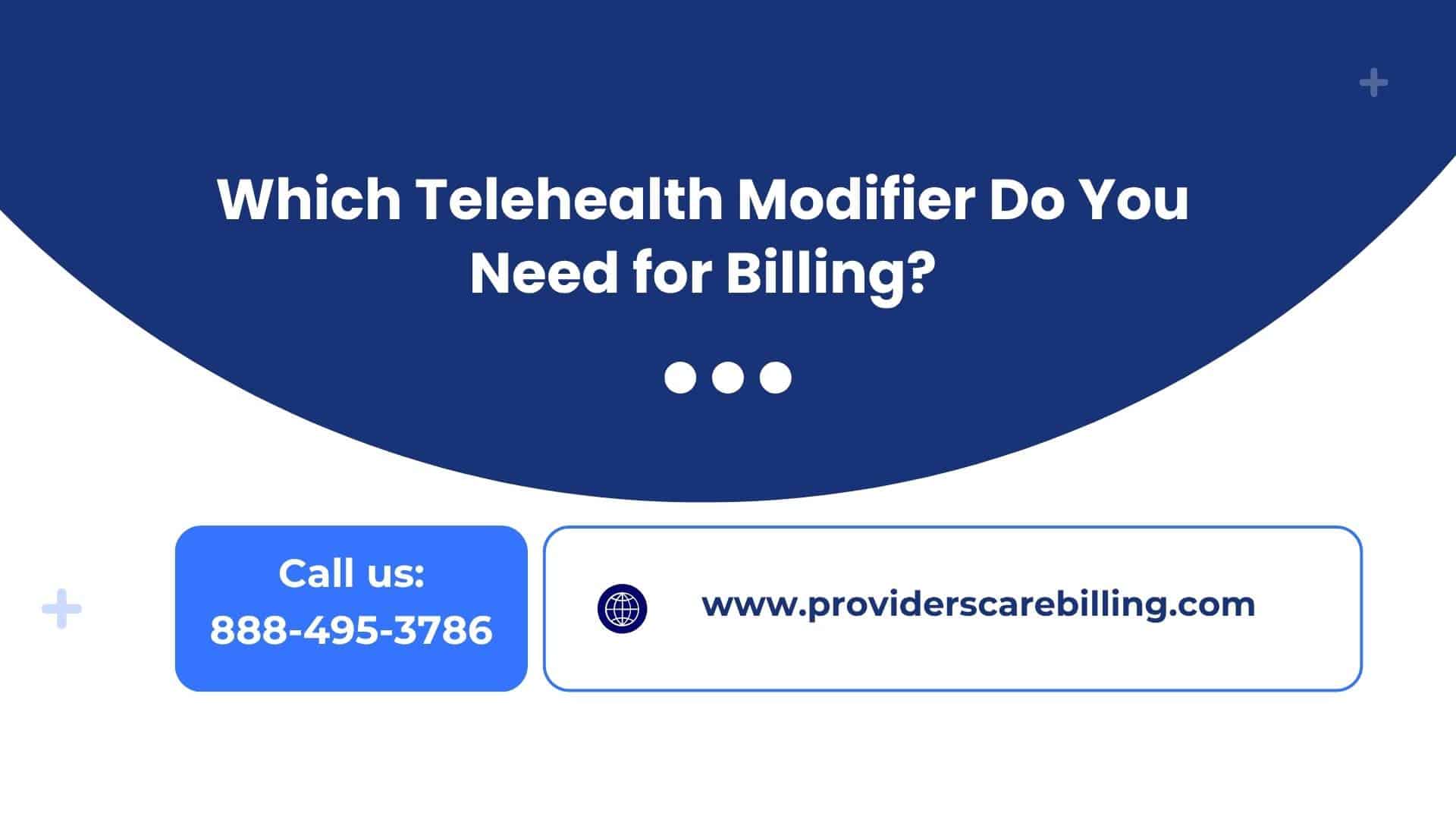In the last quarter of 2023, over 12.6 % of Medicare beneficiaries received a telehealth service.(aha.org)
A telehealth modifier shows how a service was delivered (video, audio or store-and-forward). It’s a small detail, but payers watch it closely and the wrong one can cause delays. For 2025, CMS updated several telehealth rules. These include changes to how audio-only visits are reported, revised POS guidance and adjustments to the Medicare telehealth list.
In this blog, we will learn about all the major telehealth modifiers, when to use them and how you can avoid denials or reduced reimbursement. If you need help managing claims, our Medical Billing Services ensure accurate submission and maximum reimbursement.
What Is a Telehealth Modifier?
A telehealth modifier is a code added to a medical claim to show exactly….How a service was remotely delivered. It tells the payer if the visit was done through a video call, an audio-only phone call or an asynchronous method(where information is sent and reviewed later). All the payers require these modifiers so they can apply the right rules for coverage and payment.
Common Telehealth Modifiers
- 95 – Real-time synchronous video/audio
- GT – Legacy interactive audio/video
- 93 – Audio-only telehealth
- GQ – Asynchronous / store-and-forward
Less Common / Specialty Modifiers
- FQ – Facility telehealth (sometimes used to indicate telehealth delivered in a facility setting)
- G0 – Telehealth services for preventive care under Medicare (sometimes listed separately)
- Other Payer-Specific Modifiers – Some states, Medicaid plans or commercial payers also use custom codes.
Some Core Telehealth Modifiers You Need to Understand…
In 2025, these are some of the most commonly used telehealth modifiers…This will help you understand where to use them and avoid claims at the same time.
Modifier 95 – Synchronous Telehealth (Real-Time Video)
Modifier 95 is one of the most commonly used modifiers in 2025. It applies to real-time audio/video visits across most specialties, including mental health, E/M, therapy and primary care. What is Modifier 95? It identifies a service delivered through live video.
Most payers accept the telehealth modifier 95 and it remains the standard in medical billing for virtual visits. If you’re a therapist, check out our detailed guide on Telehealth Billing for Therapists 2025 for examples specific to therapy sessions.
GT Modifier – Legacy Telehealth Indicator
The GT modifier is used for telehealth services that are delivered via interactive audio and video.
What is Modifier GT? It’s essentially an older version of Modifier 95. Medicare no longer uses it, but many commercial plans and several Medicaid programs still require modifier GT based on their policies.
Modifier 93 – Audio-Only Telehealth
Modifier 93 is used when the entire visit occurs by telephone with no video. Modifier 93 for telehealth is common in behavioural health and for patients who cannot use video. It is simply a phone-only service.
Other Telehealth Modifiers (GQ, FQ, etc.)
Modifier GQ – It is used for asynchronous or store-and-forward services…Mainly in Alaska, Hawaii, and specific Medicaid programs.
(GQ modifier description: provider reviews recorded data, not a live interaction.)
FQ Modifier – It identifies telehealth services provided in the patient’s home as required by certain payers.
What is the Difference between Modifier 95, GT and 93?
There are 2 tables down here that clearly show the difference between GT and 95, plus how 93 compares to 95.
95 and GT Modifier
| Modifier | What It Indicates | Who Uses It | Key Difference |
| Modifier 95 | Synchronous, real-time audio/video telehealth | Medicare, most Medicaid programs and most commercial payers | The modern standard – widely accepted |
| GT Modifier | Interactive audio/video telehealth | Some Medicaid programs and certain commercial plans | A legacy modifier is still required by specific payers. |
This table summarize everything…clearly – 95 is the current standard, while GT remains in use only where payers still require it.
95 and 93 Modifier
| Modifier | Visit Type | Technology Used | Key Difference |
| Modifier 95 | Full telehealth visit | Real-time audio + video | Video required |
| Modifier 93 | Audio-only telehealth | Telephone only, no video | Used when the visit cannot or does not use video |
Telehealth Billing Examples (Here’s a Quick Reference)
These are some examples to show how modifiers are added based on the type of telehealth service…
• Video psychotherapy session → 90837-95
Use modifier 95 because the visit is done through real-time video.
• Audio-only follow-up call → 99443-93
Use modifier 93 when the entire visit happens by phone with no video.
• Video E/M visit → 99214-95
Modifier 95 applies to standard evaluation and management visits delivered through video.
• Asynchronous dermatology review → 99421-GQ
Use modifier GQ when images or information are sent and the provider reviews them later, rather than in real time.
• Telehealth therapy check-in (video) → 90834-95
Another example of a synchronous video visit that requires modifier 95.
Some Payer-Specific Requirements You Must Follow in 2025
These are some different payers that follow different telehealth rules, so the modifier you use can change based on who you’re billing.
Medicare (CMS)
Medicare uses modifier 95 for real-time video visits and modifier 93 for approved audio-only services.
For most telehealth claims, CMS also requires a Place of Service (POS) code:
- POS 02 – Telehealth provided outside the patient’s home
- POS 10 – Telehealth provided in the patient’s home
Some claims need both the POS and the telehealth modifier.
Medicaid
Medicaid rules vary by state, so telehealth billing requirements are not the same everywhere.
Some states still use GT for video visits or GQ for asynchronous services. Others have moved fully to modifier 95. Because state programs update telehealth policies frequently, billers must check their state Medicaid guidelines before submitting claims.
Commercial Payers
Commercial insurance plans each follow their own telehealth billing rules:
- Aetna often uses modifier 95 but may require specific POS codes depending on the plan.
- UHC accepts modifier 95 for most video visits and may still require GT for certain legacy plans.
- BCBS rules vary by state; some plans use 95, others continue to accept GT.
Many Commercial payers update telehealth policies multiple times each year, so staying updated with the latest guidelines is essential before billing.
Take control of your telehealth revenue now and avoid costly billing errors contact Providers Care Billing and get expert support today!
FAQ’s (Frequently Asked Questions)
Do you use 95 or GT modifier for telehealth?
Most telehealth video visits use modifier 95. The GT modifier is older and mainly required only by a few Medicaid programs or specific commercial payers. Always check the payer’s current policy to avoid any denials.
What is the modifier for telehealth insurance billing?
The primary telehealth modifier for insurance billing is modifier 95. It is used for real-time audio/video services. Some payers may also require 93 (audio-only) or GT…but it all depends on their guidelines.
What is the 93 modifier for telehealth?
Modifier 93 is used for audio-only telehealth visits. This modifier tells the payer that the service was completed by phone without video.
What is a 79 modifier used for?
Modifier 79 is not a telehealth modifier. It is used when a provider performs an unrelated procedure during the postoperative period of another surgery. It helps make sure that the service is paid separately from the global surgical package.
Is modifier 95 still required for telehealth services in 2025?
Yes. Most commercial payers and Medicare Advantage plans still require modifier 95 for standard video telehealth visits in 2025. Some Medicaid programs may use GT, but 95 remains the widely accepted standard.
What is the modifier 02 for telehealth?
Modifier 02 does not exist, but POS 02 does. POS 02 is used to show that the patient received care through telehealth, while the provider delivered the service from a location outside the patient’s home. If the patient was at home for the telehealth service, then POS 10 is used.




